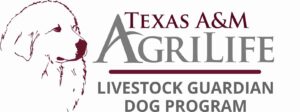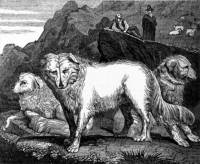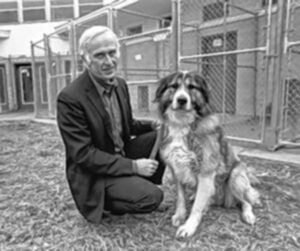With colder weather approaching, now is a crucial time to ensure your LGDs are in proper body condition. Dogs are rated using a one-to-nine body condition scoring system developed by Purina Mills. The ideal BCS for an LGD is 4.5 on the scale, with most dogs falling between 3.5 and 5 throughout the year. As spring approaches, we recommend that your LGDs have a BCS of at least 5 so they can keep up with predators during lambing and kidding season. Dogs are scored similarly to other animals, with a focus on their ribs and backs. Working dogs should have a “tuck” from the rear of their chest to their hips, which typically indicates a score of 4.5. No ribs or spinal bones should be visible from a distance, but should be felt with light pressure when touched.
If your LGDs are currently rated below a BCS 4, additional feeding is recommended. Depending on their size, kenneling may be necessary for one to two weeks to help them gain extra weight. Predation should remain very light or nonexistent during this time, as it takes time for your LGDs’ scent marking to fade from their territory. You will lose more animals from a thin dog in the spring that can’t do its job properly than you will by kenneling it for a couple of weeks to help it gain weight.
AgriLife Livestock Guardian Dog Program: Update and Events
 The Texas LGD Association held a field day on October 25 at the Texas Ranger Hall of Fame in Waco. The event took place from 9:00 a.m. to 4:00 p.m. and featured workshops, vendors, and dog breeders. The in-person association meeting was canceled due to technical issues. Morning refreshments and lunch were provided with registration. Speakers at the event included myself, Dr. John Tomecek, AgriLife Research Wildlife Specialist, and Sky Toney from Noble Research Institute. Several vendors were also present on site.
The Texas LGD Association held a field day on October 25 at the Texas Ranger Hall of Fame in Waco. The event took place from 9:00 a.m. to 4:00 p.m. and featured workshops, vendors, and dog breeders. The in-person association meeting was canceled due to technical issues. Morning refreshments and lunch were provided with registration. Speakers at the event included myself, Dr. John Tomecek, AgriLife Research Wildlife Specialist, and Sky Toney from Noble Research Institute. Several vendors were also present on site.
We have Dr. Katherine Lord scheduled to present at our webinar on November 20th at 3 pm CST. Dr. Lord will share data from Darwin’s Ark Canine DNA Project’s working dog collection, of which she is a member. We strongly encourage all LGD owners to participate in the working dog project to help gather data on various types of working dog breeds. Check our Facebook page @TAMUlivestockguarddog for more information, and visit the events page on the Center’s website to register.
What is a Livestock Guardian Dog?
This month, we will explore what a livestock guardian dog is in a two-part series. A livestock guardian dog, or LGD, is a dog specially bred to protect livestock from predators. These dogs are medium to large, often weighing over 100 pounds. They are most commonly used to guard sheep, goats, and poultry, but more ranchers are now using them to protect cattle as well. In some areas, LGDs have even been deployed to guard native bird populations. In regions with large predators like wolves and bears, cattle ranchers also rely heavily on these dogs.
LGDs live full-time with the animals they protect, becoming part of the flock or herd. Their guarding instinct is primarily innate, strengthened by close bonding with livestock at a young age. Unlike herding dogs, which guide the movement of animals, LGDs blend in with the herd and aim to deter threats. Many LGD breeds were traditionally chosen to match the coat colors of the animals they guarded in Europe: white for those among wool sheep, and fawn, spotted, or darker shades for dogs guarding goats or hair sheep.
Historical Background
The use of guardian dogs is an ancient practice, with written references dating back to Roman times, over 2,000 years ago. Roman sources described several types of dogs, including mastiff-like guardians and shepherd dogs, some of which were large animals kept among flocks to protect them against predators. This demonstrates that the concept of protective dogs accompanying livestock has a deep historical foundation.
Scholars often suggest that modern LGD breeds originated from regional mixes of mastiff-type dogs and early shepherd dogs. This blending may explain the variation seen within breed standards today, including differences in head shape, coat, and body size. Over centuries, various cultures refined these landrace populations into effective guardians, adapting them to local conditions.
LGDs in the United States
In the U.S., the large-scale use of LGDs began in the 1980s through the research of Dr. Raymond Coppinger and his colleagues. Their work
introduced and tested European guardian breeds on American ranches, laying the foundation for current LGD programs. Unlike in Europe, where shepherds often guide dogs alongside flocks on open rangelands, American LGDs typically guard independently within perimeter or cross-fenced areas. These dogs are intelligent and independent, requiring minimal direction once they reach maturity, typically between 18 and 24 months old. However, their long-term success heavily depends on proper bonding and management during the first months of life.
Lifespan, Bonding, and Roaming Challenges
Producer surveys indicate that many LGDs do not reach old age, as many are removed from service or lost before six years. The main causes are accidents, culling due to poor performance, and roaming. Specifically, roaming is often linked to weak early bonds with livestock. To reduce these risks, LGDs should be introduced to the herd as early as possible, ideally within the first few weeks of life. During this early socialization period, regular contact with the animals they are meant to guard is crucial. This helps establish strong bonds and decreases the likelihood of future problems, such as aggression toward stock or excessive roaming.
Bonding and Training Practices
The imprinting process in LGDs is believed to be mainly guided by smell, although sight and sound also play a role. The critical bonding period occurs between three and sixteen weeks of age. Pups should be introduced to livestock during this time and stay close to them for at least six months. Daily supervision and basic training are essential during this period. Puppies need to learn to remain calm around livestock, respond to basic commands, and accept human handling. Many producers find it helpful to pair young dogs with experienced guardians, who model proper behavior and help correct mistakes. Even with this support, most LGDs are not considered fully reliable until they reach about two years of age.
Adult Dogs and Bonding Project Update
Round 7 Pups
The pups are doing well. We moved their pastures around to ensure that they are actually bonded to the cattle as a species, rather than to the specific cattle they are training with. So far, the move has gone smoothly, and the dogs have acclimated to the new pastures and the cattle. The overall project to protect the swift foxes in northern Texas is progressing well, and the dogs will be placed on cooperating producer ranches in March 2026. This is a bit longer than we have done in the past, but the lead professor is having difficulties finding producers to participate. If you ranch and have land in the Rita Blanca National Grasslands in Dalham County, TX, Cimarron County, OK, or Union County, NM, and are interested in participating in this unique project, please contact me at bill.costanzo@ag.tamu.edu.
In closing
If you enjoyed this monthly LGD blog, please remember to subscribe using this link: The Guardian Way | Texas A&M AgriLif e Research and Extension Center at San Angelo.
e Research and Extension Center at San Angelo.
Do you have any feedback about this article, or would you like to propose topics for future articles, webinars, or workshops? Please do not hesitate to contact me at bill.costanzo@ag.tamu.edu or 325-657-7311.
Are you seeking information on LGDs? Please visit our website, which features factsheets, global research on LGDs, and case studies we have conducted.
Follow us on our social media platforms and share them with your friends and family!
Facebook, Instagram, YouTube: TAMUlivestockguarddog
Be sure to visit the Texas LGD Association online! You can follow the organization on Facebook or YouTube under @TexasLGDAssociation or visit its website.
to visit the Texas LGD Association online! You can follow the organization on Facebook or YouTube under @TexasLGDAssociation or visit its website.
Texas A&M AgriLife provides equal opportunities in its programs and employment to all persons, regardless of race, color, sex, religion, national origin, disability, age, genetic information, veteran status, sexual orientation, or gender identity. The Texas A&M University System, U.S. Department of Agriculture, and the County Commissioners Courts of Texas Cooperating.







